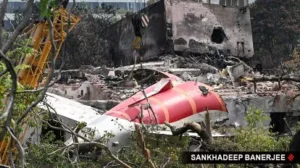Ahemdabad Air India Crash Report : Know details
Ahemdabad Air India Crash Report : Inside the Cockpit, Fuel Switches and the Fatal Crash of Air India Flight 171 Primary report published.
What is the context of Ahemdabad Air India Crash Report?
In the worst Indian aviation disaster in over four decades, investigators have uncovered a haunting technical mystery:
The moments after takeoff, both engines of Air India Flight 171 lost power when the fuel control switches abruptly moved from “RUN” to “CUTOFF.”
The crash, which took place on June 12 in Ahmedabad, claimed all 260 lives aboard plus 60 plus on ground left a densely populated neighborhood scarred by falling wreckage.

Primary investigation of Ahemdabad Air India Crash Report
Now, a preliminary 15-page report by the Aircraft Accident Investigation Bureau (AAIB) has offered the first detailed insight into what might have gone wrong aboard the Boeing 787-8 Dreamliner—an aircraft considered among the safest in the world.
A Normal Takeoff—Until It Wasn’t : Ahemdabad Air India Crash Report
Flight 171 had begun like any other.
Co-pilot Clive Kundar was at the controls, while senior commander Sumeet Sabharwal was monitoring.
Both pilots had cleared pre-flight breathalyzer tests and had sufficient rest.
Aircraft maintenance checks were all current, with no noted defects in the past year related to the fuel control systems.
The Dreamliner lifted off smoothly from Ahmedabad’s Sardar Vallabhbhai Patel International Airport under clear skies.
It reached an altitude of roughly 625 feet before vanishing from radar within 50 seconds of takeoff.
Seconds before the engines failed, voice recordings captured one pilot asking, “Why did you cut off the fuel?” The other responded, “I didn’t.”
The Fatal Fuel Switches
At the heart of the incident lies the cockpit’s throttle control module.
According to the AAIB, the twin-engine aircraft’s fuel switches—mechanisms critical to the flow of fuel into the engines—were somehow toggled to the “CUTOFF” position just moments after takeoff.
Designed to be nearly impossible to activate accidentally, these switches are equipped with protective brackets and a lock-lift feature that requires deliberate motion.
Experts stress that this movement couldn’t have been accidental.
“You’d need to lift and flip both switches, likely with both hands, in under a second. That’s not something that just happens,” said a senior aviation engineer familiar with Boeing’s control systems.
The switches were later found in the “RUN” position in the wreckage, suggesting they may have been reset in a desperate attempt to regain engine power.
One engine did relight during descent but never regained full thrust; the other remained unresponsive.
Safety Alerts Ignored?
In 2018, the US Federal Aviation Administration (FAA) issued a Special Airworthiness Information Bulletin (SAIB).
Bulletin issued warning about potential disengagement of the fuel switch locking feature—particularly in Boeing 737s, which use the same fuel switch module as the 787s.
But as the bulletin was advisory, not mandatory, Air India did not conduct a recommended inspection.
The cockpit’s throttle module had been replaced twice—in 2019 and 2023—but for unrelated issues.
Despite this, the AAIB clarified that no existing defects were reported in the fuel system. All applicable safety bulletins and directives had been followed.
Investigators are now probing whether pilot error, miscommunication, or a rare system malfunction triggered the switch toggle.
Engine Power Gone in Seconds
As the engines shut down, the aircraft’s Ram Air Turbine (RAT)—a backup wind-driven power generator—deployed, and the Auxiliary Power Unit (APU) activated.
Both are emergency systems that kick in when main engine power is lost.
However, with the aircraft at low altitude and climbing, there was no time or room to recover.
The plane plunged into a densely packed Ahmedabad locality, flattening homes and sparking fires. Rescue crews could do little beyond containment.
What Happens Next?
With no indications of mechanical failure in the engines or the aircraft frame, the focus now turns squarely toward the cockpit.
The final report may take up to a year, but with this detailed preliminary report, investigators appear to be closing in fast.
In the words of one expert close to the investigation, “The question is not what failed—but who moved the switches, and why.”
Until then, the skies remain clouded by tragedy, and unanswered questions.
Read Also: US State Department Layoffs
